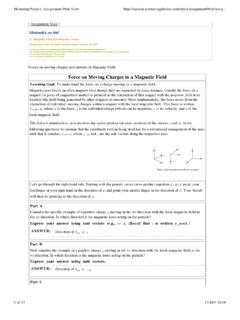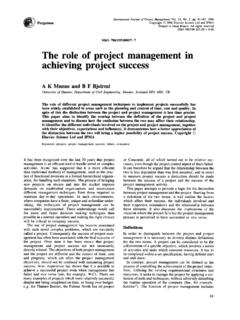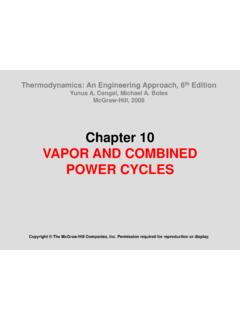Transcription of Chapter 2 The hydrological cycle - hi
1 Chapter 2 The hydrological cycleThe hydrologic cycle is a conceptual model that describes the storage and movementof water between the biosphere, atmosphere, lithosphere, and the hydrosphere (seeFigure ). Water on this planet can be stored in any one of the following reservoirs:atmosphere, oceans, lakes, rivers, soils, glaciers, snowfields, and moves from one reservoir to another by way of processes like evaporation,condensation, precipitation, deposition, runoff, infiltration, sublimation, transpira-tion, melting, and groundwater flow. The oceans supply most of the evaporated wa-ter found in the atmosphere. Of this evaporated water, only 91% of it is returned tothe ocean basins by way of precipitation. The remaining 9% is transported to areasover landmasses where climatological factors induce the formation of resulting imbalance between rates of evaporation and precipitation over landand ocean is corrected by runoff and groundwater flow to the is continually cycled between its various reservoirs.
2 This cycling oc-curs through the processes of evaporation, condensation, precipitation, deposition,runoff, infiltration, sublimation, transpiration, melting, and groundwater flow. describes the approximate residence times of water in the major reservoirs. Onaverage water is renewed in rivers once every 16 days. Water in the atmosphere iscompletely replaced once every 8 days. Slower rates of replacement occur in largelakes, glaciers, ocean bodies and groundwater. Replacement in these reservoirs cantake from hundreds to thousands of years. One of the oldest groundwater is foundbeneath the Sahara desert in Egypt (Nubian aquifer), where the water ages rangefrom about 200 ka to 1 million years old, depending on location [18].Some of these resources (especially groundwater) are being used by humans atrates that far exceed their renewal times. This type of resource use is making thistype of water effectively year the turnover of water on Earth involves 577,000 km3of water.
3 This iswater that evaporates from the oceanic surface (502,800 km3) and from land (74,200km3). The same amount of water falls as atmospheric precipitation, 458,000 km3on the ocean and 119,000 km3on land. The difference between precipitation andevaporation from the land surface (119,000 - 74,200 = 44,800 km3/year) representsthe total runoff of the Earth s rivers (42,700 km3/year) and direct groundwater runoff15162 The hydrological cycleFig. of thehydrological FlowRainto the ocean (2100 km3/year). These are the principal sources of fresh water tosupport life necessities and man s economic hydrologic cycle is a model of the movement of water through the Earthsystem. It also is a pathway through which energy is transferred between the surfaceof the earth and the atmosphere. The unequal distribution of water leaves its imprinton the surface of the earth through the mosaic of biomes and landforms sculptedby the power of moving water and ice.
4 Human survival requires adequate and safewater resources. The future of those resources hinge on our understanding of thedelicate balance of water in our earth water balance is an accounting of the inputs and outputs of water. The waterbalance of a place, whether it is an agricultural field, region, or continent, can bedetermined by calculating the input and output of water. The major input of water isfrom precipitation and output is evapotranspiration. The geographer C. W. Thornth-waite (1899-1963) pioneered the water balance approach to water resource and his team used the water-balance methodology to assess water needs for irri-gation and other water-related is constantly moving within and above the earth in a cycle called the hy-drologic cycle . Not only is the hydrologic cycle a cycle of water, it is a cycle ofenergy as well. There are six major components of this cycle : evapotranspiration,condensation, precipitation, infiltration, percolation and recycles the earth s water supply through a process known as the watercycle or hydrologic cycle .
5 This cycle operates continuously and receives energyfrom the hydrologic cycle consists of inflows, outflows, and storage. Inflows add wa-ter to the different parts of the hydrologic system, while outflows remove is the retention of water by parts of the system. Because water movement iscyclical, an inflow for one part of the system is an outflow for at an aquifer as an example, percolation of water into the ground is aninflow to the aquifer. Discharge of ground water from the aquifer to a stream isan outflow (also an inflow for the stream). Over time, if inflows to the aquifer aregreater than its outflows, the amount of water stored in the aquifer will , if the inflows to the aquifer are less than the outflows, the amount ofwater stored and outflows can occur naturally or result from human CondensationDefinition is the cooling of water vapor until it becomes a the dew point is reached, water vapor forms tiny visible water droplets.
6 Whenthese droplets form in the sky and other atmospheric conditions are present, cloudswill form. As the droplets collide, they merge and form larger droplets and eventu-ally, precipitation will generally occurs in the atmosphere when warm air rises, cools andlooses its capacity to hold water vapor. As a result, excess water vapor condenses toform cloud droplets. The upward motions that generate clouds can be produced byconvection in unstable air, convergence associated with cyclones, lifting of air byfronts and lifting over elevated topography such as moisture that falls from the atmosphere as rain, snow, sleet, varies in amount, intensity, and form by season and geographic lo-cation. These factors impact whether water will flow into streams or infiltrate intothe ground. In most parts of the world, records are kept of snow and rainfall. Thisallows scientists to determine average rainfall for a location as well as classify rainstorms based on duration, intensity and average return period.
7 This information iscrucial for crop management as well as the engineering design of water controlstructures and flood The hydrological cycleThe water vapor may condense back into a liquid and in so doing, releases la-tent heat which is converted into sensible heat that warms the surrounding air. Thiswarming fuels the uplift of air to help promote adiabatic cooling and further con-densation. As droplets of water coalesce into larger droplets they attain a size bigenough to fall towards the earth s surface as precipitation. Located high in the tropo-sphere they possess a high degree of potential energy that is converted into kineticenergy once they begin to fall toward the surface. Impacting the surface they con-vert this kinetic energy into work done on the surface (erosion for example). Ratherthan condensing and precipitating directly back into the ocean, water vapor may betransported to some other location where it condenses and precipitates EvaporationDefinition is the phase change of liquid water into a is an important means of transferring energy between the surface andthe air above.
8 The energy used to evaporate water is called latent energy . Latentenergy is locked up in the water molecule when water undergoes the phase changefrom a liquid to a gas. Eighty-eight percent of all water entering the atmosphereoriginates from the ocean between 60 degrees north and 60 degrees south of the water evaporated from the ocean returns directly back to the water is transported over land before it is precipitated conversion of water from a liquid into a gas. Approximately 80% of allevaporation is from the oceans, with the remaining 20% coming from inland waterand vegetation. Winds transport the evaporated water around the globe, influencingthe humidity of the air throughout the evaporated water exists as a gas outside of clouds and evaporation is moreintense in the presence of warmer temperatures. This is shown in the image above,where the strongest evaporation was occurring over the oceans and near the equator(indicated by shades of red and yellow).
9 EvapotranspirationDefinition is the combined net effect of evaporation uses a larger portion of precipitation than the other processesassociated with the hydrologic is the process of returning moisture to the atmosphere. Water onany surface, especially the surfaces of mudholes, ponds, streams, rivers, lakes, andoceans, is warmed by the sun s heat until it reaches the point at which water turnsinto the vapor, or gaseous, form. The water vapor then rises into the and percolation19 Transpiration is the process by which plants return moisture to the air. Plants takeup water through their roots and then lose some of the water through pores in theirleaves. As hot air passes over the surface of the leaves, the moisture absorbs the heatand evaporates into the is the evaporation of water into the atmosphere from the leavesand stems of plants. Plants absorb soilwater through their roots and this water canoriginate from deep in the soil.
10 (For example, corn plants have roots that are deep, while some desert plants have roots that extend 20 meters into theground). Plants pump the water up from the soil to deliver nutrients to their pumping is driven by the evaporation of water through small pores called sto-mates , which are found on the undersides of leaves. Transpiration accounts forapproximately 10% of all evaporating is the combination of water released to the atmosphere byevaporation and transpiration. Actual evapotranspiration is the amount of water de-livered to the air from these two processes. Actual evapotranspiration is an outputof water that is dependent on moisture available at the surface, temperature and hu-midity. Think of actual evapotranspiration as water use, that is, water is actuallyevaporating and transpiring given the environmental conditions of a place. Actualevapotranspiration increases as temperatures increase, so long as there is water toevaporate and for plants to transpire.











